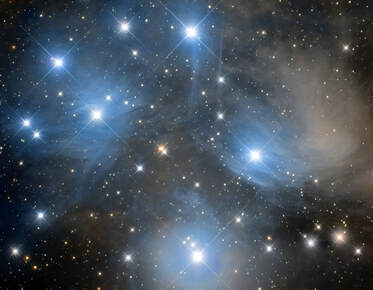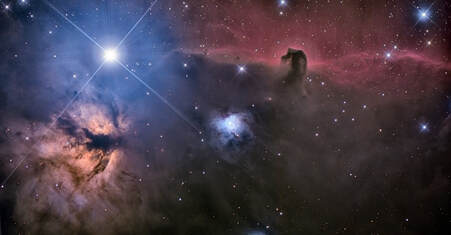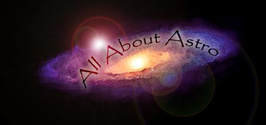
Check out the newest image posted to the Astrogallery! It's a four frame mosaic of M45, taken a couple of years ago but only now finished. Clicking the image will take you directly to the details.
Known from the earliest of antiquity and mentioned three times in the Bible, the "Pleiades" or the "Seven Sisters," is inarguably the night sky's most beautiful star cluster. Illuminating the autumn sky, it seems to signify a cool, refreshing end to our hot Texas summer!
But cool they are not. Among some of the the hottest stars in the sky, these blue beauties shine brightly from their position approximately 440 light years away.
So who are the "Seven Sisters"? In ancient Greek myth, the sisters were the daughters of Altas and Pleione. Their offspring, the "seven sisters," are shown in my image (Atlas and Pleione would be outside the bottom of this frame).
So where are the stars going? As they were birthed together, they are moving in mostly the same direction, as sisters like to do, toward the "feet" of Orion from our sky perspective. Orion, "the hunter," in Greek mythos, is said to be protecting the sisters from Taurus, "the Bull." So perhaps it's smart of the girls to be headed in that direction.
But I wonder if they realize that the bull is actually standing between them and their rescuer in the night sky?
Known from the earliest of antiquity and mentioned three times in the Bible, the "Pleiades" or the "Seven Sisters," is inarguably the night sky's most beautiful star cluster. Illuminating the autumn sky, it seems to signify a cool, refreshing end to our hot Texas summer!
But cool they are not. Among some of the the hottest stars in the sky, these blue beauties shine brightly from their position approximately 440 light years away.
So who are the "Seven Sisters"? In ancient Greek myth, the sisters were the daughters of Altas and Pleione. Their offspring, the "seven sisters," are shown in my image (Atlas and Pleione would be outside the bottom of this frame).
So where are the stars going? As they were birthed together, they are moving in mostly the same direction, as sisters like to do, toward the "feet" of Orion from our sky perspective. Orion, "the hunter," in Greek mythos, is said to be protecting the sisters from Taurus, "the Bull." So perhaps it's smart of the girls to be headed in that direction.
But I wonder if they realize that the bull is actually standing between them and their rescuer in the night sky?

 RSS Feed
RSS Feed
